[Source: Darren Kitson]
The Class 501 and Class 488 Passenger Stock
As we have seen, not very much is known about earlier passenger stock at Marchwood so what little is known has been described with image captions. The Class 501 and Class 488 stock is rather better known so warrants fuller descriptions.
Class 501 was originally known as 'London District' stock. There were a class of 57 3rd and 4th rail 630V DC 3-car multiple units with bodies built at Eastleigh on 57ft underframes built at Ashford. Their appearance was similar to the Southern EPB stock but with a number of differences. The 4th rail ability was due to the sharing of part of the Watford route with London Transport's Bakerloo Line. For this reason all lines they operated were originally fitted with the 4th rail system, including into Broad Street. Built in 1955/6, the London District units replaced the ex-LNWR Oerlikon stock plus the later LMS-built sets and during the transition period all types could be seen in operation.
Routes operated by Class 501 were Euston - Watford Junction; Watford Junction to Croxley Green; Broad Street to Richmond; Broad Street - Watford Junction (peak times only and via Primrose Hill). The LNWR DC lines once covered other routes, such as to Rickmansworth Church Street and the long-forgotten Willesden Junction - Kensington Olympia - Earls Court service but Class 501 came far too late for these and especially the latter.
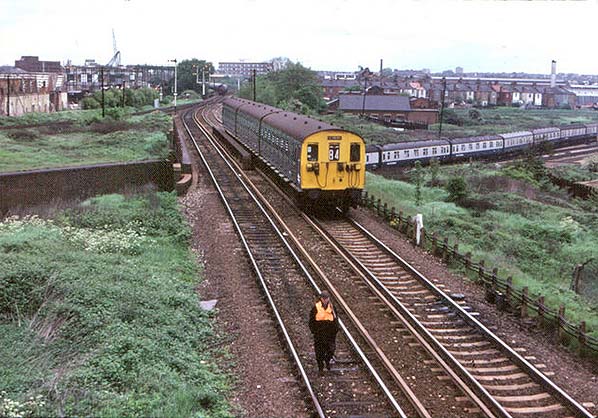
A Class 501 EMU seen here in May 1979. It is en route to Richmond and crossing the Western Region main line at Acton. Note the stabled sleeping cars. A lengthman is inspecting the permanent way in the foreground. The EMU is running on the 3rd rail section; part of the Richmond route was shared with the Southern Region and this involved some complex electrical circuitry to permit operation of the two types of train at different voltages. From 1970 the units were altered to 3rd rail operation but the 4th rail was of course retained on sections used by London Transport. Isolated sections of redundant 4th rail on non-LT sections could still be seen for some years afterwards.
Photo by Martin Addison and reproduced from Geograph under Creative Commons Licence
Features of Class 501 were the bars over the door droplights, owing to limited clearances, and the intermediate trailers originally being of compartment layout. Most of the latter were converted to open layout, including that which ended up at Marchwood. The writer has vivid memories of travelling out of a ghostly and deserted Broad Street during the off-peak on an equally deserted Class 501 accompanied by the smell of stale tobacco and, often, urine. The class was superseded by Class 313 and, for a time after North Woolwich was electrified, also by Southern Region units, and finally bowed out in 1985 by which time most were in refurbished blue/grey livery.
A number entered departmental service and a couple of individual cars have made it into preservation, including one of those which worked at Marchwood. The Marchwood pair were Driving Trailer Second M75186 and Trailer Second (a centre car) M70170 although the 'M' prefix had probably been dropped by this time. Class 501 was air braked and this appears to have been the reason for their appearance at Marchwood as MoD locomotives required train air brakes to operate main line freight vehicles which had switched to air braking as standard. At Marchwood most, but not all, of the bars over door droplights were retained and the vehicles were painted army green with yellow ends. The name ‘MARCHWOOD MILITARY RAILWAY’ was applied in full, together with crest, on the bodysides. They were given numbers Army WGP 8808 (ex-70170) and Army WGP 8809 (ex-75186). Quite when they arrived at Marchwood is unclear but it was likely during the late 1980s soon after withdrawal by BR. The Class 501 cars were disposed of during 2006, probably because of deteriorating condition. They were replaced by a 2-car Class 488 set.
Class 488 were the locomotive-hauled Gatwick Express sets dedicated to the Victoria - Gatwick Airport service. These trains used Mark 2F air conditioned coaches built from 1973 and originally used on the Midland main line out of St Pancras. In the style of the former Southern Railway and its predecessors the coaches were formed into sets; Class 488/2 being 2-car sets comprising a First Open and a Second Open and Class 488/3 being 3-car sets comprising all Second Opens. On Gatwick Express services the stock was formed into rakes of at least five cars and normally eight with a Class 73 Electro-Diesel at the country end and an ex-2-HAP Driving Motor converted into a luggage van at the London end. The trains thus ran as push-pull units. There were ten members of Class 488/2 and nineteen members of Class 488/3 but not all were in service across the total years of operation
The Class 488 designation was a little odd as it was in a series normally used for Southern Region electric multiple-units although it was not unique as the Southern Region's former TC trailer sets were also given set numbers in the same series. Class 488 sets also followed Southern practice in that they were given 4-digit set numbers, for example 488210 was given set number 8210. In other words the set number was the class number minus the first two digits. Set 8210 was that which ended up at Marchwood, it having been withdrawn (from Gatwick Express) back in 2002. The set comprised First Open 72509 and Second Open 72635, their original numbers being 3398 and 6128 respectively. The 7xxxx number series was also used for electric multiple-unit stock. The ex-2-HAP vehicles became Class 489 and these also bore unit numbers comprising the last four digits, thus 489101, for example, bore unit number 9101. Class 489 was classified GLV; Gatwick Luggage van and not Guard Luggage Van.
Gatwick Express began life as, of course, just another British Rail service but with so-called rail 'privatisation' it became a franchise on its own. Set 8301, however, was to be spared the horrors of 'privatisation' as it was involved in the Battersea Park accident of 1985 and withdrawn. Class 488 survived in service until 2005, the final members being retained to deputise for the troublesome and absolutely hideous Class 460 'Darth Vader' electric multiple-units. Fortunately Class 460 is no longer with us, its vehicles being used to strengthen Class 458 (which are also hideous but far less so) or stripped for spares and scrapped. On the plus side, if there is one, Class 460 had a generous luggage van - unlike the totally unsuited Class 442 which replaced them on Gatwick Airport services.
At Marchwood set 8210 ended up in a variation of the DLO purple livery with the outermost gangway doors painted yellow. Roofs were grey, window frames, door handles, grabrails and edges of footboards were white The set does not appear to have carried the Marchwood Military Railway name but did have crests and retained Gatwick Express car numbers, painted in white on the lower bodyside adjacent to the doors at one end and diagonally opposite on the other side. The set number, however, was omitted. The ends of the coaches between the purple bodysides and the gangways were black.
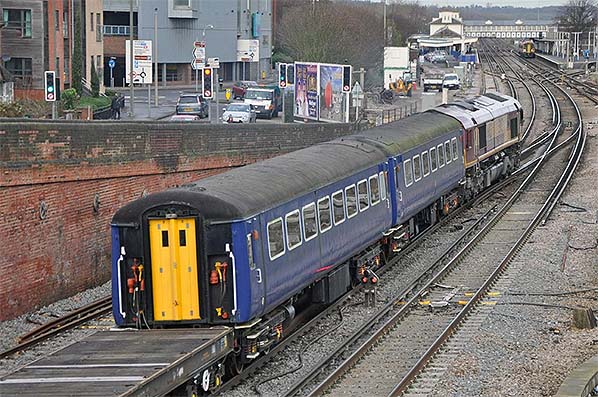
A Class 501 EMU seen here in May 1979. It is en route to Richmond and crossing the Western Region main line at Acton. Note the stabled sleeping cars. A lengthman is inspecting the permanent way in the foreground. The EMU is running on the 3rd rail section; part of the Richmond route was shared with the Southern Region and this involved some complex electrical circuitry to permit operation of the two types of train at different voltages. From 1970 the units were altered to 3rd rail operation but the 4th rail was of course retained on sections used by London Transport. Isolated sections of redundant 4th rail on non-LT sections could still be seen for some years afterwards.
Photo courtesy Carl Watson from his Carl's Railway Photos website
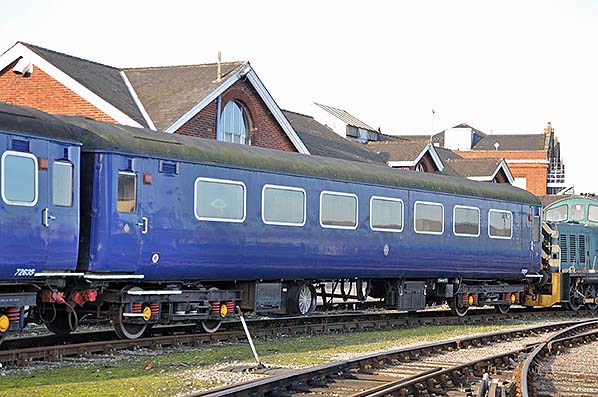
On arrival at Eastleigh from Marchwood, the Class 488 set was taken to Eastleigh East Yard. The following day they were taken to Eastleigh Works by the weekly East Yard - Works trip. With a degree of irony the set is seen here being shunted by Ruston & Hornsby LSSE Class 07
No.07007 (originally D2991).
Photo courtesy Carl Watson from his Carl's Railway Photos website
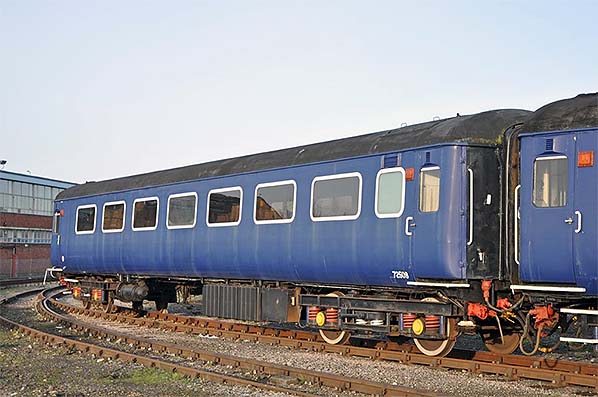
The ex-Gatwick Express Class 488 set in the sidings at Eastleigh Works on 16 December 2014. On this occasion the camera was on the opposite side of the train to the previous view. Note the set retained its Gatwick Express car numbers and did not receive army numbers; this was because the set arrived at Marchwood after the army ceased to operate the trains themselves. The livery is a variation of the standard DLO livery and would have looked very smart when freshly painted. Unsurprisingly car 72509, in particular, is showing signs of fading. It also lacks the crest applied midway along the bodyside of its partner, car 72635. As of November 2016 the set, we are informed by the photographer who is an employee at Eastleigh, is in store at Eastleigh works and is owned by Arlington Fleet Services. Thus set 488210 and one of Marchwood's ex-Class 501 cars are, as far as is known, the only survivors of the Marchwood Military Railway's passenger stock.
Photo courtesy Carl Watson from his Carl's Railway Photos website
Following the end of Class 488 usage on Gatwick Express and excepting the Marchwood set, some vehicles were re-gauged and sent to Northern Ireland and New Zealand, in the latter case for use on steam specials with the Mainline Steam Heritage Trust where they operate alongside a sizeable fleet of other ex-BR coaches. Other Class 488 members were scrapped, a few ended up with heritage railways and a few went to Railtrack, later Network Rail, for departmental use. Of Class 489, some were scrapped, some went to heritage railways and some went into departmental service as de-icing units, remaining in service at the time of writing. Of the Class 73 electro-diesels, some are with heritage railways, a few have been scrapped but a number remain in service. Of the latter, some are being rebuilt into Class 73/9 by the fitting of far more powerful MTU engines in place of the original and rather feeble English Electric 4SRKT MkII; this and the earlier MkI were the same engines as used in the 'Thumper' DEMU sets.
A General note on Military Railways and their Passenger Trains
All three main branches of the British Armed Forces have, or have had, involvement with railways in one form or another with the most prolific being the army. Military railways or military trains running on main lines can trace their history back to the American Civil War of 1861-65. The usual purpose has been movement of troops and equipment but, staying with Britain, a number of army camps have had, and still have, internal rail networks with many of these operating passenger services at one time or another. Perhaps the best known were those of the sadly-now-gone Longmoor Military Railway which had a quite extensive system. Longmoor was a railway training camp; the Royal Engineers were at one time responsible for the construction, operation, repair and maintenance of railways at home and abroad, especially during periods of conflict. It was from the Royal Engineers that the vast majority of the Board of Trade and later HM Railway Inspectorate inspectors came who passed, or otherwise, new railways for opening and who were in charge of investigating and reporting on accidents. Most were retired officers of the rank of Captain or higher and frequently Major or Lieutenant - Colonel. What these men did not know about railways was not worth knowing and it is a great shame that the function has now been effectively replaced by civil servants, text book at the ready in a back pocket, and in the case of accidents seemingly also with swarms of police doing their best to turn any railway accident into a 'crime scene'.
Passenger trains on military systems have usually been formed of stock discarded by the main line railways, the best known of which was perhaps the large fleet at Longmoor. The now-defunct Bramley Military Railway (near Basingstoke) also had a fleet of ex-London Transport tube cars. Some military railways made use of small railcars and typically those of D Wickham & Co, with Longmoor again perhaps being the most prolific. Otherwise passenger stock has always been of the locomotive-hauled type, which is fine for training purposes but in the case of small 'out and back' systems like Marchwood, where the only requirement is to shuttle personnel back and forth, locomotive-hauled stock was arguably something of an overkill.
One therefore has to wonder why use was not made of ex-main line diesel railcars or railbuses. In the 1960s BR disposed of numerous diesel multiple-units of the 79xxx series which were still in perfectly serviceable condition as well as the 4-wheel railbuses. Whilst the latter became something of a joke on the main line, one of them would have been ideal for the short and infrequent passenger shuttles at Marchwood and indeed at other camps; likewise with the Class 121/2 single units when BR disposed of them. Firms such as Wickham were perfectly capable of manufacturing bespoke railcars but as far as is known they were never approached by the military with this in mind, apart from in connection with their small petrol trolleys which at best could carry a dozen-or-so people.
Perhaps the answer lies in ex-main line railcars or railbuses or bespoke railcars requiring additional training and stocks of spare parts which the military considered unjustified when their personnel were already trained on existing locomotives. We will probably never know the truth but on the plus side the military's use of discarded main line stock, both passenger and goods, has ensured the survival of a number of antiquities into preservation.
As we have seen, the operation of military railways and other military assets is now in the hands of semi-civilian agencies and organisations - a situation which causes the writer, and no doubt many others, feels some unease. Sadly the direct involvement of the military with railway operation came to an end in 2014 with the disbanding of 275 Railway Troop, Territorial Army.
Railtours at Marchwood
The Marchwood Military Railway has seen a number of railtours over the years. Some have ventured only as far as the Network Rail, as it is today, boundary or the gate marking the perimeter of MoD property. Others have ventured deeper, sometimes as far as the 'Buffer Zone' (the military complex being divided into three zones, namely Reception, Buffer and Port) but usually as far as the jetties. Most railtours are described more fully on the Disused Stations Fawley branch pages although not all of those ventured onto MoD property. Unfortunately photographs are not available of all tours but the few that are will be shown below. Marchwood has also occasionally staged open days and during these a shuttle has been provided on the internal rail system but such are not classed as railtours. When a locomotive-hauled railtour visits Marchwood MoD it is usual for the train to be taken forward by MoD locomotives, one exception being the use of No.76017 as shown below although this locomotive did not arrive with a railtour.
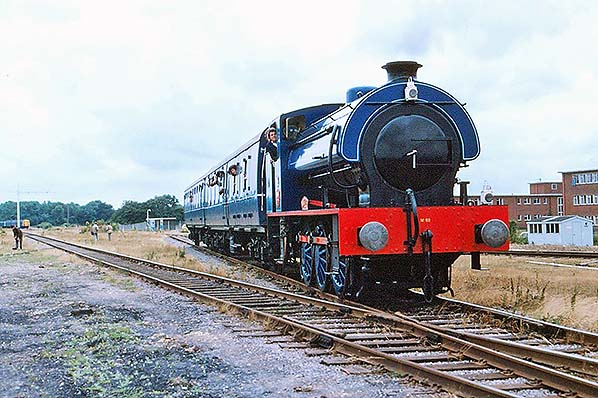
During the July 1978 open day, Army No.92 is seen leaving the exchange sidings with Marchwood's passenger train which at the time comprised two ex BR Mk1 vehicles. A BR train comprising a pair of Southern Region DEMU's can be seen in the exchange sidings, left background. The DEMU facing the camera is a member of what became Class 207 and originally known variously as '3D', 'Oxted' or 'East Sussex' units.
Photo by Andy Crespin
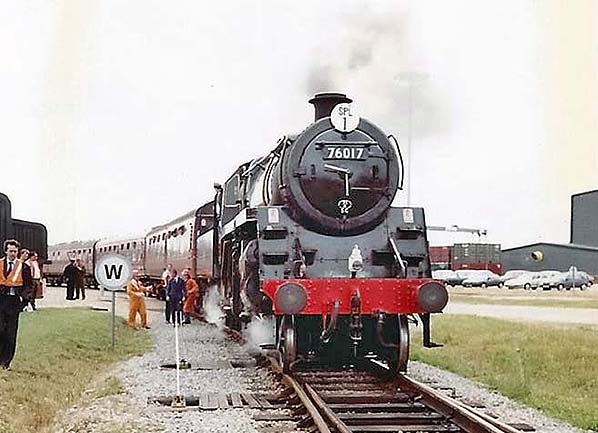
BR Standard 4MT 2-6-0 No.76017 at Marchwood on the occasion of The Branch Line Society's 'The Hampshire & Sussex Explorer' on 19 June 1993. No.76017 was present for a Families’ Day at Marchwood and did not operate any part of the railtour on the national network. She arrived at Marchwood under her own steam from the Mid Hants Railway, a journey which would have been straightforward had the southern section of the Mid Hants Line not been abandoned. On the same day at Marchwood, Class 47 diesel No.47213 was named 'Marchwood Military Port' to mark the 50th anniversary of the port's opening although it was not fifty years to the day.
Photo by Julian Isaac
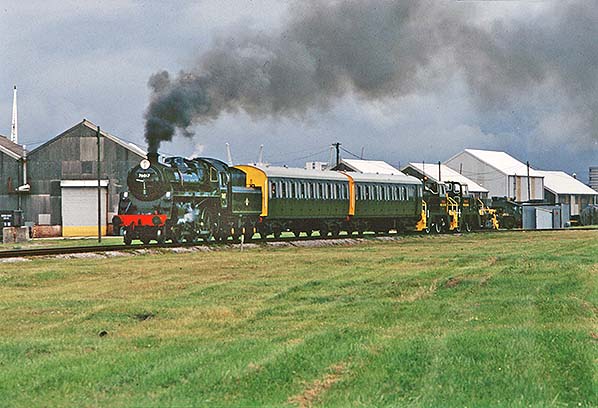
Marchwood on 19 June 1993, the occasion of the Branch Line Society’s 'The Hampshire & Sussex Explorer' Seen in this view is BR Standard 2-6-0 No.76017 with the Army's two ex-Class 501 coaches and pair of Thomas Hill shunters. The latter are recorded as being Army Nos.255 and 268 which, assuming that the numbers have been recorded correctly, is the only reference to this pair being at Marchwood. Both are carrying nameplates but which plates are not known as they remained at Marchwood and were applied/removed as locomotives came and went. The tour details make no mention of the ex-Class 501 coaches but clearly they were used. This view is believed to show the ensemble returning from Falklands Jetty via the Northern Line, after which the tour visited the Cracknore Hard branch but apparently using the main line stock.
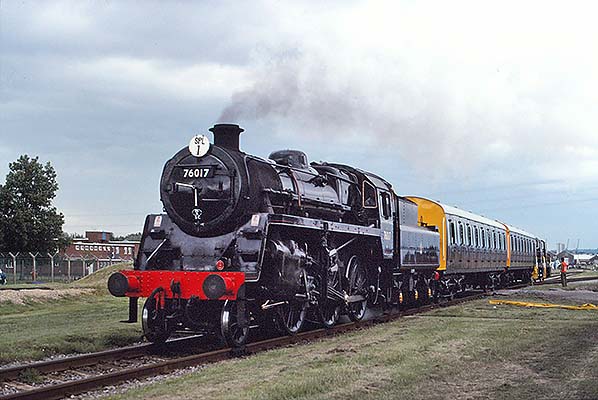
BR Standand 4MT No.76017 stands near the locomotive shed offices during the open day of 19 June 1993. She is operating one of the shuttles using Marchwood's ex-Class 501 passenger stock. A pair of Thomas Hill diesel shunters are on the other end of the train. As mentioned elsewhere, No.76017 had arrived at Marchwood by road from the Mid Hants Railway; some sources incorrectly suggest she travelled under her own steam but to have done so would have involved a very circuitous and costly route indeed. She is standing upon flat-bottom rails fastened with Pandrol clips, as used on the main line, with what appear to be wooden sleepers as opposed to the distinctive military style concrete sleepers common elsewhere on the Marchwood site. The locomotive carries a 71A (Eastleigh) shedplate which is historically correct as Eastleigh was one of only two sheds she was based at during her BR life, the other being Salisbury. Marchwood in June 1993 was not the only occasion No.76017 was used as a crowd-draw for during August 1954, when a little over one year old, she was an exhibit at Eastleigh Works open day. The 'SC' on her smokebox door signifies a self-cleaning smokebox. This device pulverised ash before ejecting it from the chimney. The idea was to reduce maintenance, ie manual smokebox cleaning, and to this end was successful although it did not, nor was it intended to, eliminate manual cleaning entirely but merely reduced the frequency. Note that the passenger stock retains bars over most, but not all, door droplights. These were fitted by BR to what were originally known as the 'LMR London District' units to avoid decapitations due to limited clearances on part of the North London Line. These bars could also be found on certain other stock depending on operating area. Of the two Marchwood Class 501 vehicles, the driving trailer (second vehicle from the camera), formerly M75186, was to enter preservation and at the time of writing was languishing at the
Electric Railway Museum, Coventry.
Photo by Andy Crespin
 The title 'Marchwood Volunteer No.2' suggests that there was also a No.1 and indeed there was, on 22 July 1978, although it was titled simply 'The Marchwood Volunteer'. This tour ran from and to Waterloo and used 'East Sussex' Class 207 DEMU sets 1306 and 1313. The tour visited Hamble and Fawley as well as venturing onto the Marchwood Military Railway.
The title 'Marchwood Volunteer No.2' suggests that there was also a No.1 and indeed there was, on 22 July 1978, although it was titled simply 'The Marchwood Volunteer'. This tour ran from and to Waterloo and used 'East Sussex' Class 207 DEMU sets 1306 and 1313. The tour visited Hamble and Fawley as well as venturing onto the Marchwood Military Railway.
Pathfinder Tours 'The Logistician' visited Marchwood on 24 June 1995 and spent a little short of two hours on the military railway. Click here to download a 12 page PDF detailed itinerary of the tour.
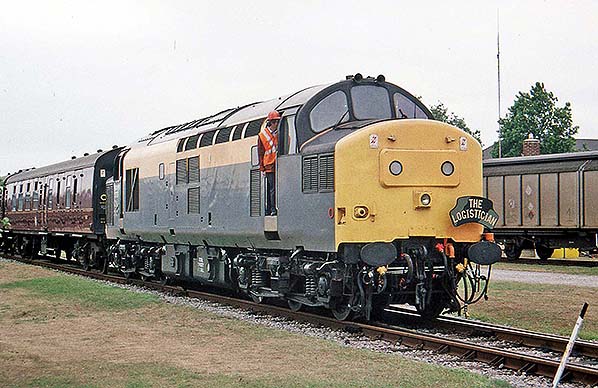
English Electric Class 37 No.37371 on the Marchwood Military Railway with Pathfinder Tours 'The Logistician' railtour on 24 June 1995. This tour ran to and from Bristol Temple Meads and took in Ludgershall as well as Marchwood. Three Class 37s were used although one, 37048, was a replacement for 37098 which failed at Didcot. The stock was a 6-car set and the Mark 1 seen here looks very smart in lined maroon livery. Note the bars over the passenger door droplights. A Ferrywagon can be partially seen on the right. These are lengthy bogie vehicles which come in a number of variations. None of three Class 37s used on ‘The Logistician’ survive. No.37371 entered traffic on 13 June 1963 as D6847 and was scrapped at Wigan in June 2001. Nevertheless, there is still work for Class 37 and number of them continue in service as of November 2016 with a large number now in preservation of which a few have been re-acquired and returned to the main line. Despite their age and notwithstanding various rebuilds, the class has proved to be among Britain's most dependable main line diesels ever.
Photo by Steve Jones from his Flickr photostream
Freight Traffic
As with all military railways, Internal User wagons have occasionally been purpose-built vehicles but overwhelmingly they are discarded stock from the main line railways. Four-wheel vans of just about all types imaginable have been used and often these originated in Pre-Grouping days (prior to 1923). One type of wagon which was once extremely common, both on the main lines and military railways was the gunpowder van. These vans resembled a standard box van but were steel-clad, wood-lined and often with lead covering the wood. They had to be spark-proof, both from external sources and from their own components, thus such items as door handles, hinges and runners were of brass. Brake blocks were also usually shielded to protect from sparks. Many of these vans were also used to carry ammunition, which of course also contained gunpowder, as well as other flammable materials. They continued to be built by British Railways but, it is thought, only to a total of around 160. Marchwood Military Railway opened too late to see swarms of gunpowder vans but nevertheless they would have once been a regular sight.
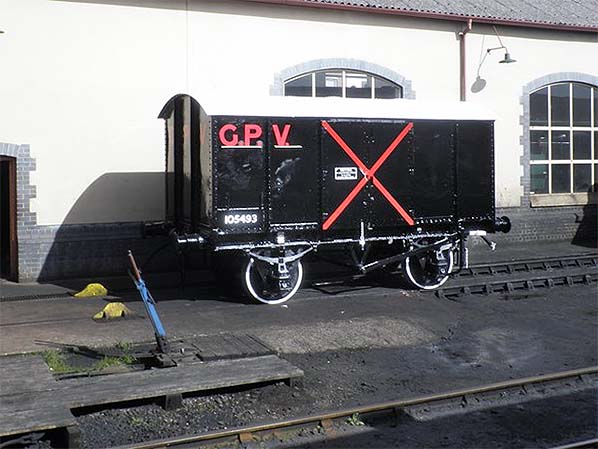
A restored gunpowder van seen here at Minehead in March 2013. The red cross on the doors is a 'No Smoking' warning. A number of these vans, of varying parentage (this one began life with the Great Western Railway), have been preserved but in comparison to the vast numbers constructed over many decades they are now rare.
Photo by Roger Cornfoot and reproduced from Geograph under Creative Commons Licence
Another type of van which for some reason ended up in quantity on military and industrial railways was the Palvan (Pallet Van). These had been introduced by BR in an attempt to capture pallet load traffic and were a variation of the standard 12-ton box van. Palvans had a large, heavy sliding door on each side but at the diagonally opposite ends. BR built 2388 Palvans but whilst BR’s intentions were honourable the vans were unsuccessful. They were awkward to load and when loaded the load could shift or be unevenly distributed, the latter especially when access was possible only from one side. The result was a tendency to de-rail. Their suspension, which had both primary and secondary elements, did not help and most Palvans were withdrawn during the 1960s with, as described, many being sold on to industry and the military where low running speeds and their large doors made them rather more suitable. Like gunpowder vans, some Palvans have made it into preservation but can now also be considered rare. One can be seen at Marchwood in the February 1976 photograph of Austerity No.92.
Wagons more associated with the military and could - and still can - be seen at Marchwood are the various types of flat and well wagons; Warflat; Warwell; Rectank, Ramp and so on. These are the wagons which carry anything from Land Rovers to boats and tanks. Marchwood has Internal User examples but others can also be seen on the main line from time to time as they are the only means by which heavy equipment such as tanks can be moved en masse around the country. Examples can be seen in a few photographs within this article, for example a Rectank can also be seen in the February 1976 view of Austerity No.92.
Marchwood also saw VEA munitions vans running to and from the main line. These were short wheelbase 4-wheel vans and were taken out of revenue service on the main line during the 1990s and some 45 of this type ended up as Internal User vans at Marchwood; a few may still exist along with some ex-BR goods brakevans. The VEAs were replaced on traffic to and from the main line by various types of long wheelbase 4-wheel vans, typically VAA, VBA, VDA and VGA types. As of 2016 a number of these plus some PVA curtain-sided vans are Marchwood Internal User vehicles.
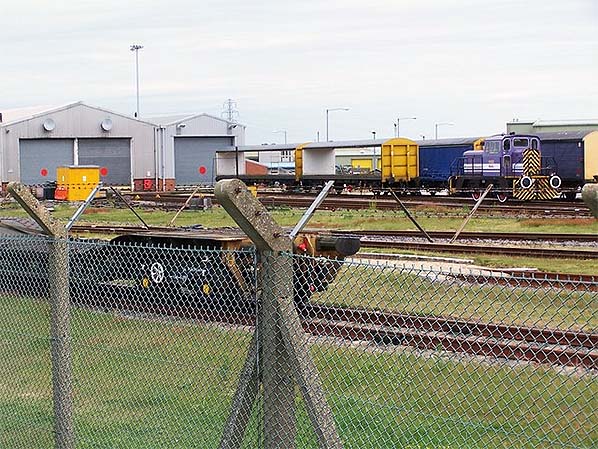
The view across the fence in May 2011 looking towards the locomotive shed and maintenance bay. This was a Sunday, the one day of the week that the military railway does not operate under normal circumstances. In the foreground is a Warwell wagon while in the background is a pair of PVA curtain-sided vans, minus curtains. Behind them is another PVA, with curtains present, plus what appears to be a VBA behind the DLO-liveried Thomas Hill shunter. By this date all these vans were most likely Internal User. Long wheelbase air-braked vans such as these had the advantage of being able to operate at higher speeds relative to the older short wheelbase vans which tended to become unstable and were restricted to, at best, 45mph or 60mph for the XP rated types. It was these long wheelbase underframes upon which the 'Nodding Donkey' Pacer DMUs were based but with a number of significant differences, not least the longer (30ft against 20ft 9in) wheelbase of the Pacer vehicles.
Photo by David Martin and reproduced from Geograph under Creative Commons Licence
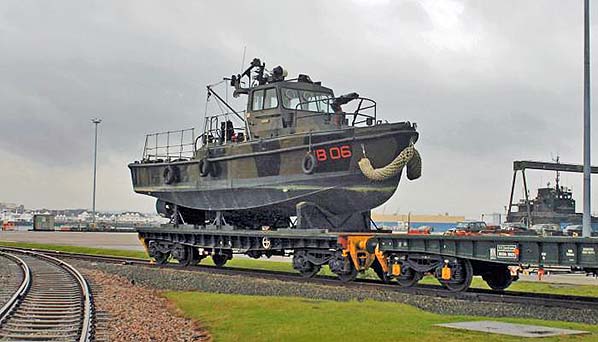
Army Work Boat WB 06 on a BAOR (British Army On The Rhine) Warflat at Marchwood on an unknown date. Work Boats are general hacks used for a number of purposes; firefighting for which they are fitted with a pump; diving support; barge towing; tenders. Their purpose at Marchwood appears to have largely comprised the towing of barges to and from moorings in Southampton Water. The cradles on which WB 06 is sitting can be removed from the wagon and placed on the deck of ships where they serve the same purpose as seen here. This particular type of Work Boat is believed to be no longer in service.
Photo from Wikimapia, reproduced under creative commons licence
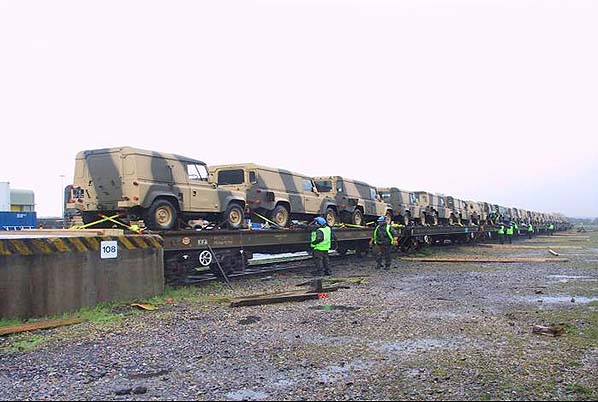
A fleet of Land Rovers loaded onto KFA Warflats, which are essentially container flats, at Marchwood on an unknown date. This photograph illustrates well the convenience of transporting fleets of vehicles and other equipment by rail, by which means it travels direct from depot to depot mainly in the hands of one person - the locomotive driver. The Land Rovers are the long wheelbase type, of which three can be accommodated on each wagon.
Photo from Wikimapia, reproduced under creative commons licence
Freight to Marchwood in the 21st Century
Other than movements such as the train of Land Rovers seen above, freight to and from the main line is now invariably containerised and usually operated by the General Motors Class 66 diesel locomotives. Upon arrival at Marchwood station the token procedure with the signalman is undertaken, after which the train moves forward to Marchwood Junction and onto the military railway spur. At the gate the driver obtains permission from military railway staff to continue to the reception/exchange sidings. There, the locomotive is uncoupled and the internal locomotives take over. The main line locomotive may return either light engine or, if required, outgoing loaded or empty wagons. On occasion the reverse applies; a locomotive will arrive light engine at Marchwood and return with wagons. Upon leaving the military railway the driver is required to contact Marchwood signalman for permission to continue and when granted the trap points and ground signals are set accordingly. At Marchwood station, the military railway can be accessed only from the down Fawley branch, i.e. the platform road. Since cessation of traffic to Fawley in September 2016 the down road is now the only one in use through Marchwood station.*
As of December 2016 there is Monday - Friday train from Eastleigh; dep. Eastleigh 08:34 arr. Marchwood MOD 09:11 Mondays and dep. Eastleigh 09:14 arr. Marchwood MOD 10:08 Tuesday - Friday. On all days it is booked to depart Marchwood MOD at 11:00, arriving Eastleigh 11:36. It is, however, a 'Q Train' which means it runs only as required and at the time of writing operates on average three times per week. Anybody hoping to catch it on camera is advised, as is often the case with freight trains, that it can run early in the down direction and is frequently late in the up direction and often by over an hour.
[*As an interesting aside, there is a departmental train from Eastleigh (Arlington) Monday - Friday which is booked to take a circuitous route back to Eastleigh via Weymouth, Fareham, Fratton, Eastleigh and Fawley. Network Rail's data suggests that it usually runs, on the Fawley branch, only as far as Marchwood but does actually continue to Fawley on one day out of the five. At the time of writing it apparently last did so on 9 November 2016 and this is despite the Marchwood - Fawley section being officially 'mothballed'. The train is booked to reach Fawley at 14:00 and if anybody can confirm, or otherwise, that it does indeed venture to Fawley we would be interested to know.]
Click here to continue Marchwood Military Railway









 The title 'Marchwood Volunteer No.2' suggests that there was also a No.1 and indeed there was, on 22 July 1978, although it was titled simply 'The Marchwood Volunteer'. This tour ran from and to Waterloo and used 'East Sussex' Class 207 DEMU sets 1306 and 1313. The tour visited Hamble and Fawley as well as venturing onto the Marchwood Military Railway.
The title 'Marchwood Volunteer No.2' suggests that there was also a No.1 and indeed there was, on 22 July 1978, although it was titled simply 'The Marchwood Volunteer'. This tour ran from and to Waterloo and used 'East Sussex' Class 207 DEMU sets 1306 and 1313. The tour visited Hamble and Fawley as well as venturing onto the Marchwood Military Railway.





 Home Page
Home Page